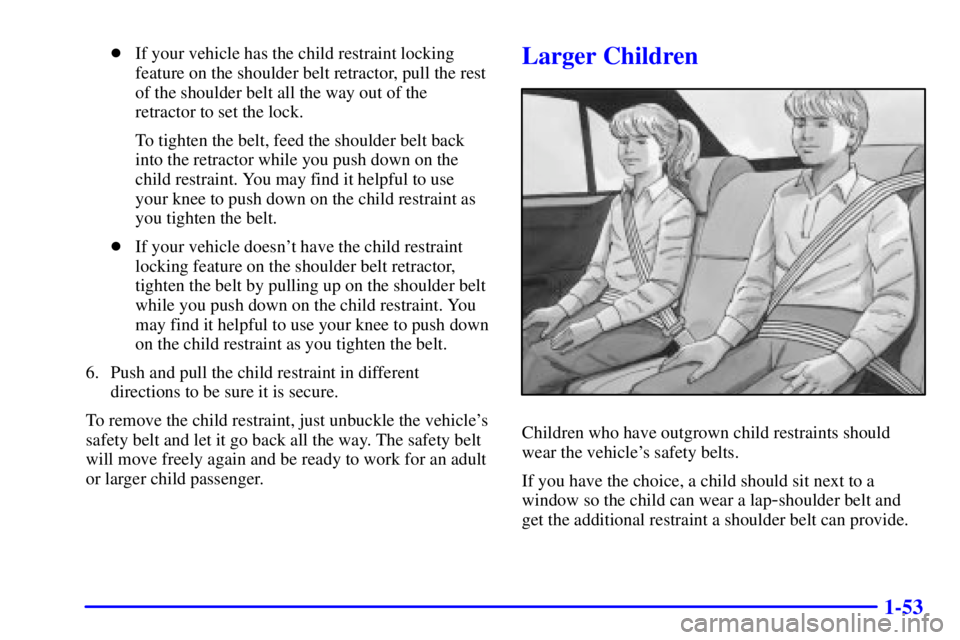Page 4 of 376
ii
Table of Contents
Keys and Door Locks
Keyless Entry System (If Equipped)
Remote Trunk Release (If Equipped)
Automatic Transaxle
Parking Brake
Power Windows
Tilt Wheel
Turn Signal/Multifunction Lever
Windshield Wipers
Cruise Control (If Equipped)
Interior and Exterior Lamps
Mirrors
Storage Compartments
Convenience Net (If Equipped)
Accessory Power Outlet (If Equipped)
OnStar® System (If Equipped)
Sunroof (If Equipped)
Instrument Panel, Warning Lights and Gages
Head-Up Display (Option)
Driver Information Center (If Equipped) Seats and Seat Controls
Safety BeltsSupplemental Restraint System (SRS)
Child Restraints
Section
1
Section
2
Seats and Restraint Systems
Features and Controls
Page 34 of 376
1-22
The best way to protect the fetus is to protect the
mother. When a safety belt is worn properly, it's more
likely that the fetus won't be hurt in a crash. For
pregnant women, as for anyone, the key to making
safety belts effective is wearing them properly.
Right Front Passenger Position
To learn how to wear the right front passenger's safety
belt properly, see ªDriver Positionº earlier in
this section.
The right front passenger's safety belt works the same
way as the driver's safety belt
-- except for two things.
If the belt stops before it reaches the buckle, tilt the latch
plate and keep pulling until you can buckle the belt.
On some vehicles, if you pull the shoulder portion of the
belt out all the way, you will engage the child restraint
locking feature. If this happens, just let the belt go back
all the way and start again.
Page 57 of 376
1-45
4. Some vehicles have a child restraint locking feature
on the shoulder belt retractor. You can tell if your
vehicle has this feature by pulling the shoulder belt
all the way out of the retractor. Then, let the belt go
back a few inches, and try to pull the belt out again.
If you can't pull the belt out because it has locked,
it means the retractor has the child restraint locking
feature. If the belt doesn't lock and you can pull the
belt out of the retractor again, it means your vehicle
doesn't have the child restraint locking feature on the
shoulder belt retractor.
Page 58 of 376

1-46
�If your vehicle has the child restraint locking
feature on the shoulder belt retractor, pull the rest
of the shoulder belt all the way out of the
retractor to set the lock.
To tighten the belt, feed the shoulder belt back
into the retractor while you push down on the
child restraint. If you're using a forward
-facing
child restraint, you may find it helpful to use your
knee to push down on the child restraint as you
tighten the belt.
�If your vehicle doesn't have the child restraint
locking feature on the shoulder belt retractor,
tighten the belt by pulling up on the shoulder belt
while you push down on the child restraint. If
you're using a forward
-facing child restraint you
may find it helpful to use your knee to push down
on the child restraint as you tighten the belt.
5. Push and pull the child restraint in different
directions to be sure it is secure.
To remove the child restraint, just unbuckle the vehicle's
safety belt and let it go back all the way. The safety belt
will move freely again and be ready to work for an adult
or larger child passenger.
Page 63 of 376
1-51
5. Some vehicles have a child restraint locking feature
on the shoulder belt retractor. You can tell if your
vehicle has this feature by pulling the shoulder belt
all the way out of the retractor. Then, let the belt go
back a few inches, and try to pull the belt out again.
If you can't pull the belt out because it has locked, it
means the retractor has the child restraint locking
feature. If the belt doesn't lock and you can pull the
belt out of the retractor again, it means your vehicle
doesn't have the child restraint locking feature on the
shoulder belt retractor.
Page 65 of 376

1-53
�If your vehicle has the child restraint locking
feature on the shoulder belt retractor, pull the rest
of the shoulder belt all the way out of the
retractor to set the lock.
To tighten the belt, feed the shoulder belt back
into the retractor while you push down on the
child restraint. You may find it helpful to use
your knee to push down on the child restraint as
you tighten the belt.
�If your vehicle doesn't have the child restraint
locking feature on the shoulder belt retractor,
tighten the belt by pulling up on the shoulder belt
while you push down on the child restraint. You
may find it helpful to use your knee to push down
on the child restraint as you tighten the belt.
6. Push and pull the child restraint in different
directions to be sure it is secure.
To remove the child restraint, just unbuckle the vehicle's
safety belt and let it go back all the way. The safety belt
will move freely again and be ready to work for an adult
or larger child passenger.Larger Children
Children who have outgrown child restraints should
wear the vehicle's safety belts.
If you have the choice, a child should sit next to a
window so the child can wear a lap
-shoulder belt and
get the additional restraint a shoulder belt can provide.
Page 72 of 376

2-4
Door Locks
CAUTION:
Unlocked doors can be dangerous.
Passengers -- especially children -- can easily
open the doors and fall out. When a door is
locked, the inside handle won't open it.
Outsiders can easily enter through an unlocked
door when you slow down or stop your vehicle.
This may not be so obvious: You increase the
chance of being thrown out of the vehicle in a
crash if the doors aren't locked. Wear safety belts
properly, lock your doors, and you will be far
better off whenever you drive your vehicle.
There are several ways to lock and unlock your vehicle.
To unlock either front door from outside the vehicle
with your key, insert it fully into the door key cylinder
and turn it counterclockwise.You can lock either front door from outside the vehicle
with your key by inserting it fully into the door key
cylinder and turning it clockwise.
To unlock either the front or rear door from inside the
vehicle, push the manual lock lever rearward.
To lock either the front or rear door from inside the
vehicle, push the manual lock lever forward.
Page 204 of 376

4-13
Speed limit signs near curves warn that you should
adjust your speed. Of course, the posted speeds are
based on good weather and road conditions. Under less
favorable conditions you'll want to go slower.
If you need to reduce your speed as you approach a
curve, do it before you enter the curve, while your front
wheels are straight ahead.
Try to adjust your speed so you can ªdriveº through the
curve. Maintain a reasonable, steady speed. Wait to
accelerate until you are out of the curve, and then
accelerate gently into the straightaway.
Steering in Emergencies
There are times when steering can be more effective than
braking. For example, you come over a hill and find a
truck stopped in your lane, or a car suddenly pulls out
from nowhere, or a child darts out from between parked
cars and stops right in front of you. You can avoid these
problems by braking
-- if you can stop in time. But
sometimes you can't; there isn't room. That's the time for
evasive action
-- steering around the problem.
Your vehicle can perform very well in emergencies like
these. First apply your brakes. (See ªBraking in
Emergenciesº earlier in this section.) It is better to
remove as much speed as you can from a possible
collision. Then steer around the problem, to the left or
right depending on the space available.
An emergency like this requires close attention and a
quick decision. If you are holding the steering wheel at
the recommended 9 and 3 o'clock positions, you can
turn it a full 180 degrees very quickly without removing
either hand. But you have to act fast, steer quickly, and
just as quickly straighten the wheel once you have
avoided the object.
The fact that such emergency situations are always
possible is a good reason to practice defensive driving at
all times and wear safety belts properly.